La consolidación de los dispositivos móviles para el consumo de información en España
DOI:
https://doi.org/10.7764/cdi.46.1741Palabras clave:
experiencia de usuario, noticias móviles, dispositivos móviles, formatos, información, tableta, periodismo móvil, responsive designResumen
Los medios de comunicación viven en una adaptación constante para hacer frente a un consumo de información cada vez mayor desde dispositivos móviles. Esta demanda ha dado origen al periodismo móvil, pensado y adaptado específicamente para esta tecnología, y ha propiciado la aparición de nuevos formatos publicitarios para fidelizar a nueva audiencia, también móvil. Para conocer cuáles son los hábitos de los usuarios respecto del consumo de noticias desde estos dispositivos, sus formatos periodísticos preferidos y cómo interactúan con la información, esta investigación diseñó un estudio de encuesta que se administró en España, a consumidores de entre 16 y 65 años (N=555). Los resultados reflejaron la consolidación de los dispositivos móviles para el consumo de información –84,8% consultaba noticias o contenidos periodísticos en el móvil a diario, frecuentemente en el lugar de trabajo y en los tiempos muertos o de espera–, la adaptación de los medios a esta tecnología, y una predilección por las apps de redes sociales para encontrar noticias, en detrimento de las webs de los medios. También pusieron de manifiesto que el video informativo es el formato de mayor éxito entre los consumidores, aunque desde aplicaciones nativas de video, como YouTube o Vimeo. Es aquí donde los medios tienen un reto: ofrecer experiencias de consumo de video más atractivas para que el público consuma este formato en sus páginas y, por lo tanto, recurra a fuentes de información de primera mano
Descargas
Citas
https://doi.org/10.1515/gfkmir-2017-0016
Bell, E. J., Owen, T., Brown, P. D., Hauka, C., & Rashidian, N. (2017). La Prensa de las Plataformas: Cómo Silicon Valley Reestructuró El Periodismo (The Platform Press: How Silicon Valley Reeingeered Journalism). Barcelona, Spain: Blanquerna.
Cameron, D. (2009). Mobile journalism: A snapshot of current research and practice. In A. Charles & G. Stewart (Eds.), The End of Journalism: News in the Twenty-First Century (pp. 63-72). Peter Lang. https://doi.org/10.3726/978-3-0353-0150-2
Cohen, J. (1992). A power primer. Psychological Bulletin, 112(1), 155–159.
https://doi.org/10.1037/0033-2909.112.1.155
ComScore (2017). Jerarquía de Necesidades en Móvil (Mobile Needs Hierarchy). Retrieved from www.comscore.com/esl/mobile-hierarchy
ComScore. (2018). El futuro digital en perspectiva (The digital future in perspective). Retrieved from www.comscore.com/esl/GlobalDFIF2018
Chan-Olmsted, S., Rim, H., & Zerba, A. (2013). Mobile news adoption among young adults: Examining the roles of perceptions, news consumption, and media usage. Journalism & Mass Communication Quarterly, 90(1), 126-147. https://doi.org/10.1177/1077699012468742
Daidj, N. & Jung, J. (2011). Strategies in the media industry: Towards the development
of co-opetition practices? Journal of Media Business Studies, 8(4), 37–57. https://doi.org/10.1080/16522354.2011.11073530
Donner, J., Gitau, S., & Marsden, G. (2011). Exploring mobile-only Internet use: Results of a training study in urban South Africa. International Journal of Communication, 5, 574–597. Retrieved from https://ijoc.org/index.php/ijoc/article/view/750
Figueroa, P. & Codina, L. (2018). Agregadores de Noticias: Caracterización, funciones y estudios de caso (News Aggregators: Characterization, functions and case studies). Barcelona, Spain: Universitat Pompeu Fabra.
Gaitán, J. A. & Piñuel, J. L. (1998). Técnicas de investigación en comunicación social (Research techniques in social communication). Madrid, Spain: Síntesis.
Goggin, G., Martin, F., & Dwyer, T. (2015). Locative News. Mobile media, place informatics and digital news. Journalism Studies, 16(1), 37–41. https://doi.org/10.1080/1461670X.2014.890329
Hassenzahl, M. (2005). The Thing and I: Understanding the Relationship Between User and Product. In M. Blythe & A. Monk (Eds.), Funology 2 (pp. 17–31). Cham, Switzerland: Springer. https://doi.org/10.1007/1-4020-2967-5
He, W., Chen, X., Li, Y., & Qiu, Y. (2015). What leads to readers’’ satisfaction with the mobile news apps service? An investigation into the roles of content originality and user experience. Chinese Journal of Library and Information Science, 7(3), 76–89.
Herrero-Diaz, P. & Varona-Aramburu, D. (2018). Uso de chatbots para automatizar la información en los medios españoles. El Profesional de La Información, 27(4), 742–749. Retrieved from http://www.elprofesionaldelainformacion.com/contenidos/2018/jul/03.html
Ji, H., Yun, Y., Lee, S., Kim, K., & Lim, H. (2017). An adaptable UI/UX considering user’s cognitive and behavior information in distributed environment. Cluster Computing, 1-14. https://doi.org/10.1007/s10586-017-0999-9
McGrane, K. (2013, May 28). The rise of the mobile-only user. Retrieved from https://hbr.org/2013/05/the-rise-of-the-mobile-only-us
Negredo, S., Vara-Miguel, A., & Amoedo, A. (2018). DigitalNewsreport. Navarra, Spain: Universidad de Navarra.
Perreault, G. & Stanfield, K. (2018). Mobile Journalism as Lifestyle Journalism? Field Theory in the integration of mobile in the newsroom and mobile journalist role conception. Journalism Practice, 13(3), 331-348. https://doi.org/10.1080/17512786.2018.1424021
Reuters Institute. (2014). Digital news report 2014: España (Digital news report: Spain). Retrieved from https://www.unav.edu/documents/3786985/0/Reuters-Institute-Digital-News-Report-2014-Espana.pdf
Roudaki, A., Kong, J., & Yu, N. (2015). A Classification of Web Browsing on Mobile Devices. Journal of Visual Languages & Computing, 26, 82–98. https://doi.org/10.1016/j.jvlc.2014.11.010
Sevillano, M. L., Pascual, M. A., & Bartolomé, D. (2007). Investigar para innovar en la enseñanza (Research to innovate in teaching). Madrid, Spain: Pearson.
Sundar, S. S., Bellur, S., Oh, J., Xu, Q., & Jia, H. (2014). User Experience of On-Screen Interaction Techniques: An Experimental Investigation of Clicking, Sliding, Zooming, Hovering, Dragging, and Flipping. Human-Computer Interaction, 29(2), 109–152. https://doi.org/10.1080/07370024.2013.789347
Schwarz, A. (2010). La teoría de los valores noticiosos y su validez externa: cómo influyen los factores noticiosos en la cobertura de las noticias internacionales en la prensa mexicana (The theory of news values and their external validity: how news factors influence the coverage of international news in the Mexican press). In M. E. Hernández Ramírez (Coord.), Estudios sobre periodismo. Marcos de interpretación para el contexto mexicano (Journalism studies. Interpretation frameworks for the Mexican context) (pp. 19-55). Guadalajara, Mexico: Editorial de la Universidad de Guadalajara.
Venkatesh, V., Morris, M. G., Davis, G. B., & Davis, F. D. (2012). User Acceptance of Information Technoloy: Toward a Unified View. MIS Quarterly, 27(3), 425-478. https://doi.org/10.2307/30036540
Walter, T. & Hang, S. (2018, May 29). Mobile Direct Traffic Eclipses Facebook. Retrieved from http://blog.chartbeat.com/2018/05/29/mobile-direct-traffic-eclipses-facebook/
Westlund, O. (2013). Mobile news: A review and model of journalism in an age of mobile media. Digital journalism, 1(1), 6-26. https://doi.org/10.1080/21670811.2012.740273
Xiaoge, X. (2013). The mobile media experience. In M. Rao & P. A. Bruck (Eds.), Global Mobile: Applications and Innovations for the Worldwide Mobile Ecosystem (pp. 227-241). Medford, NJ: Information Today, Inc.















